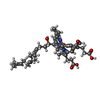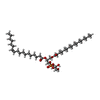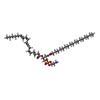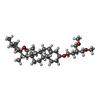+Search query
-Structure paper
| Title | Structural basis of mammalian complex IV inhibition by steroids. |
|---|---|
| Journal, issue, pages | Proc Natl Acad Sci U S A, Vol. 119, Issue 30, Page e2205228119, Year 2022 |
| Publish date | Jul 26, 2022 |
 Authors Authors | Justin M Di Trani / Agnes Moe / Daniel Riepl / Patricia Saura / Ville R I Kaila / Peter Brzezinski / John L Rubinstein /   |
| PubMed Abstract | The mitochondrial electron transport chain maintains the proton motive force that powers adenosine triphosphate (ATP) synthesis. The energy for this process comes from oxidation of reduced ...The mitochondrial electron transport chain maintains the proton motive force that powers adenosine triphosphate (ATP) synthesis. The energy for this process comes from oxidation of reduced nicotinamide adenine dinucleotide (NADH) and succinate, with the electrons from this oxidation passed via intermediate carriers to oxygen. Complex IV (CIV), the terminal oxidase, transfers electrons from the intermediate electron carrier cytochrome to oxygen, contributing to the proton motive force in the process. Within CIV, protons move through the K and D pathways during turnover. The former is responsible for transferring two protons to the enzyme's catalytic site upon its reduction, where they eventually combine with oxygen and electrons to form water. CIV is the main site for respiratory regulation, and although previous studies showed that steroid binding can regulate CIV activity, little is known about how this regulation occurs. Here, we characterize the interaction between CIV and steroids using a combination of kinetic experiments, structure determination, and molecular simulations. We show that molecules with a sterol moiety, such as glyco-diosgenin and cholesteryl hemisuccinate, reversibly inhibit CIV. Flash photolysis experiments probing the rapid equilibration of electrons within CIV demonstrate that binding of these molecules inhibits proton uptake through the K pathway. Single particle cryogenic electron microscopy (cryo-EM) of CIV with glyco-diosgenin reveals a previously undescribed steroid binding site adjacent to the K pathway, and molecular simulations suggest that the steroid binding modulates the conformational dynamics of key residues and proton transfer kinetics within this pathway. The binding pose of the sterol group sheds light on possible structural gating mechanisms in the CIV catalytic cycle. |
 External links External links |  Proc Natl Acad Sci U S A / Proc Natl Acad Sci U S A /  PubMed:35858451 / PubMed:35858451 /  PubMed Central PubMed Central |
| Methods | EM (single particle) |
| Resolution | 3.1 Å |
| Structure data | EMDB-27196, PDB-8d4t: |
| Chemicals |  ChemComp-CU:  ChemComp-MG:  ChemComp-NA:  ChemComp-HEA:  ChemComp-PGV:  ChemComp-PEK:  ChemComp-9Z9:  ChemComp-ZN: |
| Source |
|
 Keywords Keywords | MEMBRANE PROTEIN / mitochondrial electron transport chain / inhibitor / complex IV |
 Movie
Movie Controller
Controller Structure viewers
Structure viewers About Yorodumi Papers
About Yorodumi Papers






